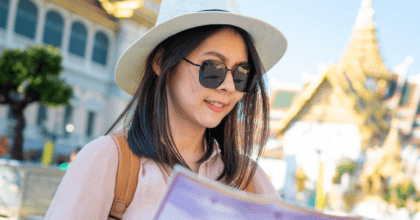Customised tours are now a popular activity among China’s wealthy travellers
With the Golden Week holiday just around the corner, it seems China’s wealthy travellers may be opting for customised tours, a niche but emerging trend in the luxury holiday market. Latest research from Mintel reveals that a third (31%) of urban Chinese consumers aged 20-49 who have travelled for leisure in the last 12 months* and spent RMB 20,000 or more per trip have gone on customised tours. Further, close to three in 10 (28%) leisure travellers who have spent RMB 10,000-20,000 a trip have also gone on customised tours. On the contrary, just 17% of leisure travellers who have spent RMB 10,000 per trip have done the same.
Yihe Huang, Research Analyst at Mintel, said:
“The customised tours market is quite niche in China. However, penetration rises significantly among luxury travellers who spend more than an average of RMB 10,000 per trip, indicating opportunity for this new, bespoke travel experience. Not only can a customised tour leverage the professional knowledge of travel agencies, it can also cater to specific needs of different travellers given its nature of personalisation. Though still specialised and mainly preferred by luxury travellers, customised tours have the potential to become a mass product in the future as travel agencies explore new ways to reduce the cost of customisation.”
A similar preference for niche offerings can also be seen through wealthy travellers’ choices of holiday destinations for the next three years. While Europe (57%), Australia/New Zealand (40%), and North America (39%) remain classic luxury travel destinations among leisure travellers in China overall, as is Southeast Asia (39%) which has been increasing in popularity in recent years, interest in niche destinations is rising among luxury holiday travellers.
Overall, just one in ten leisure travellers say that would like to visit the Middle East (11%) and South Asia (10%) in the next three years. However, when breaking things down by average travel spend, one in five (18%) leisure travellers who spend RMB 10,000-20,000 per trip have indicated that they are planning to visit the Middle East; this compares to just 8% of travellers who spend RMB 10,000 per trip. As well, one in five (18%) luxury holiday travellers who spend over RMB 20,000 a trip have expressed interest in visiting South Asia in the next three years; again, this compares to just 8% of travellers with an average spending of RMB 10,000 a trip who say the same.
“Luxury travellers are gaining more interest in niche travel destinations like the Middle East and South Asia, for instance—particularly countries like Israel, UAE, Turkey, Nepal and India. This ties in with Chinese wealthy travellers becoming more explorative of novel travel experiences, as reflected in our research. These destinations are fairly niche when compared with popular destinations like Europe, North America, Australia/New Zealand and Southeast Asia. However, Mintel predicts room in the market for tours to these niche destinations in the future. In order to further promote more travel to these niche regions, local government entities and local travel agencies could advertise more to raise awareness among consumers.” Yihe continued.
Indeed, novelty is more valued than luxury among wealthy Chinese travellers; their willingness to pay more for accomodation with unique themes (47%; eg Disney theme hotel) is higher than luxury accommodation (27%; five-star or super five-star hotel). What’s more, their willingness to pay more for unique experiences (45%; eg cycling, helicopter, snorkelling) is higher than fine meals (38%; eg Michelin-starred restaurant).
Meanwhile, holiday trips are quite common among Chinese consumers as Mintel research reveals that the majority (94%) of urban Chinese consumers aged 20-49 have taken leisure trips in the last year*. Three in five (59%) have taken two or three trips, while a sizeable one in ten (10%) have taken five or more trips. Among all leisure travellers surveyed, the average number of holiday trips taken in the last year is 2.6.
Finally, the average annual spend of urban Chinese consumers on leisure travel* is RMB 25,804, ranging from RMB 13,278 among those who have taken one trip to RMB 41,150 for those who have gone on five or more trips.
“China’s luxury holiday market has been booming in recent years as a rising number of middle class consumers continue to pursue higher-quality travel experiences. Unique lifestyle experience has replaced common sightseeing or shopping activities to become the main theme of holiday travel among Chinese travellers. Wealthy travellers, today, are keen on a comprehensive lifestyle experience including, but not limited to, local attractions, food, culture, and leisure activities when taking leisure trips. In addition, it is noteworthy that customisation is increasingly valued among wealthy travellers as it caters to their varying needs.” Yihe concluded.
*2,825 Chinese internet users aged 20-49 who have travelled for leisure in the last 12 months to February 2018.
Press review copies of Mintel’s Luxury Holidays China 2018 report and interviews with Yihe Huang, Research Analyst at Mintel, are available on request from the press office.
For the latest in consumer and industry news, top trends and market perspectives, stay tuned to Mintel News featuring commentary from Mintel’s team of global category analysts.
-
Mintel StoreGet smart fast with our exclusive market research reports, delivering the latest data, innovation, trends and strategic recommendations....View reports
-
Mintel LeapMintel Leap is a revolutionary new AI-powered platform that will transform your research process....Book a demo







































